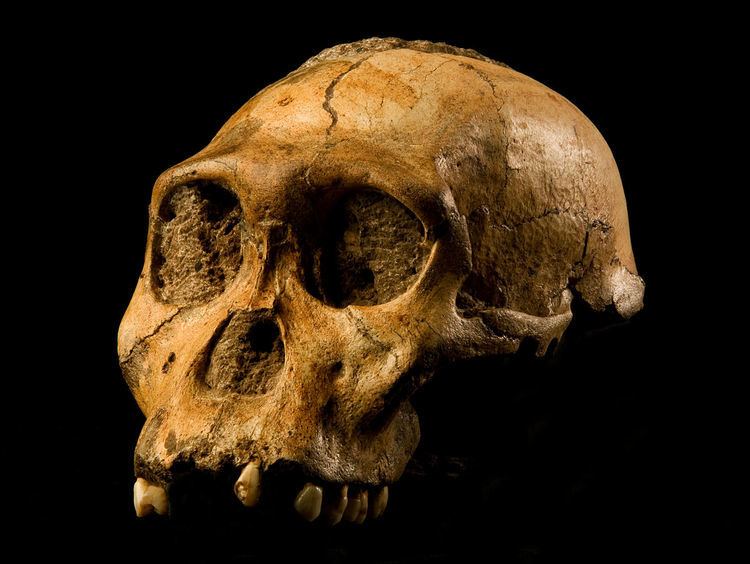Phylum Chordata Scientific name Australopithecine Rank Subtribe | ||
 | ||
Similar | ||
Australopithecines are generally all species in the related Australopithecus and Paranthropus genera, and it typically includes Kenyanthropus, Ardipithecus, and Praeanthropus. All these related species are now sometimes collectively classified as a subtribe of the Hominini tribe called Australopithecina. They are the extinct, close relatives of humans and, with the extant genus Homo, comprise the human clade. Members of the human clade, i.e. the Hominini after the split from the chimpanzees, are now called homonina (see Hominidae; terms "hominids" and hominins).
Contents
The terms australopithecine, et al., come from a former classification as members of a distinct subfamily, the Australopithecinae. Members of Australopithecus are sometimes referred to as the gracile australopithecines, while Paranthropus are called the "robust australopithecines".
The australopithecines occurred in the Plio-Pleistocene era and were bipedal, and they were dentally similar to humans, but with a brain size not much larger than that of modern apes, with lesser encephalization than in the genus Homo. Humans (genus Homo) may have descended from australopithecine ancestors and the genus Ardipithecus is a possible ancestor of the australopithecines.
Phylogeny
Phylogeny of subtribe Australopithecina according to Briggs & Crowther 2008, p. 124.
Physical characteristics
The post-cranial remains of australopithecines show they were adapted to bipedal locomotion, but did not walk identically to humans. They have a high brachial index (forearm/upper arm ratio) when compared to other hominins, and they exhibit greater sexual dimorphism than members of Homo or Pan but less so than Gorilla or Pongo. It is thought that they averaged heights of 1.2–1.5 metres (3.9–4.9 ft) and weighed between 30 and 55 kilograms (66 and 121 lb). The brain size may have been 350 cc to 600 cc. The postcanines (the teeth behind the canines) were relatively large, and had more enamel compared to contemporary apes and humans, whereas the incisors and canines were relatively small, and there was little difference between the males' and females' canines compared to modern apes.
Relation to Homo
Most scientists maintain that one of the australopithecine species evolved into the Homo genus in Africa around two million years ago. However, there is no consensus on which species:
"Determining which species of australopithecine (if any) is ancestral to the genus Homo is a question that is a top priority for many paleoanthropologists, but one that will likely elude any conclusive answers for years to come. Nearly every possible species has been suggested as a likely candidate, but none are overwhelmingly convincing. Presently, it appears that A. garhi has the potential to occupy this coveted place in paleoanthropology, but the lack of fossil evidence is a serious problem. Another problem presents itself in the fact that it has been very difficult to assess which hominid [now "hominin"] represents the first member of the genus Homo. Without knowing this, it is not possible to determine which species of australopithecine may have been ancestral to Homo."
Marc Verhaegen has argued that an australopithecine species could have also been ancestral to the Pan genus (i.e. chimpanzees).
Asian australopithecines
A minority held viewpoint among palaeoanthropologists is that australopithecines moved outside of Africa. A notable proponent of this theory is Jens Lorenz Franzen, formerly Head of Paleoanthropology at the Research Institute Senckenberg. Franzen argues that robust australopithecines had reached not only Indonesia, as Meganthropus, but also China:
"In this way we arrive at the conclusion that the recognition of australopithecines in Asia would not confuse but could help to clarify the early evolution of hominids ["hominins"] on that continent. This concept would explain the scanty remains from Java and China as relic of an Asian offshoot of an early radiation of Australopithecus, which was followed much later by an [African] immigration of Homo erectus, and finally became extinct after a period of coexistence."
In 1957, an Early Pleistocene Chinese fossil tooth of unknown province was described as resembling P. robustus. Three fossilized molars from Jianshi, China (Longgudong Cave) were later identified as belonging to an Australopithecus species (Gao, 1975). However further examination questioned this interpretation; Zhang (1984) argued the Jianshi teeth and unidentified tooth belong to H. erectus. Liu et al. (2010) also dispute the Jianshi-australopithecine link and argue the Jianshi molars fall within the range of Homo erectus:
"No marked difference in dental crown shape is shown between the Jianshi hominin and other Chinese Homo erectus, and there is also no evidence in support of the Jianshi hominin's closeness to Australopithecus."
But, Wolpoff (1999) notes that in China "persistent claims of australopithecine or australopithecine-like remains continue".
